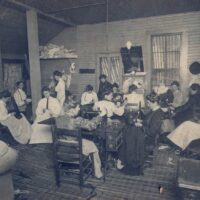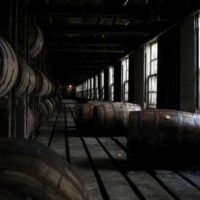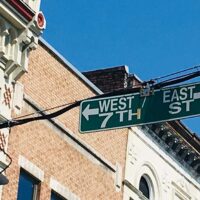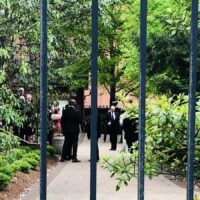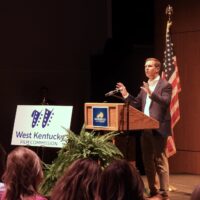A huge crowd gathers to wait for the next big event. Likely, a harness race, I imagine. Men, women, and kids pack in close to the fence to get the best view of the track while others stroll along. A lone Model T Ford is parked on the dirt pathway to the grandstand. A few folks observe the scene from the Ferris wheel high above the tents. I can almost smell the sundried red clay under their feet as the photographer releases his shutter …
CLICK!
A community moment is captured.
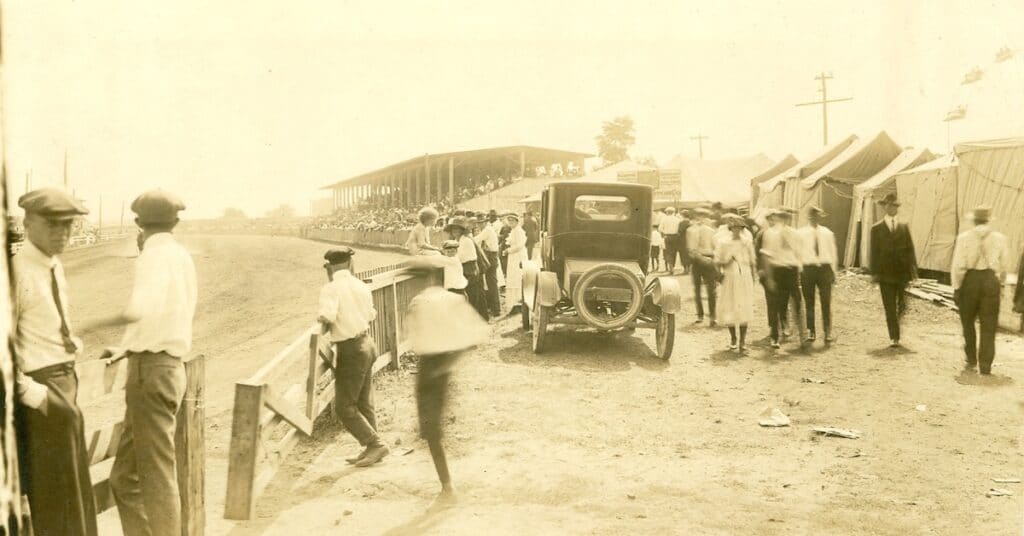
It’s fair week, y’all! From tractor pulls to death-defying rides on the midway to barbecue and funnel cakes, the sights, smells, sounds, and tastes of the Western Kentucky State Fair epitomize summertime in Christian County. I, like most of you, have great memories of the fair. I participated as a wee one in the pageants. I earned a blue ribbon for my chocolate chip cookies in the 4-H competition. I attended my very first concert — Clay Walker in the mid 1990s — in the grandstand. I skipped church on Wednesday nights to go to the demolition derby with my friends, and I still consider the demolition derby to be the best night of the summer. And every year, I call my friend (and fellow church-skipper) Angie to see if she plans to join me in the stands.
This photograph takes us back to an earlier fair in Christian County. Likely dating to around 1922, this image shows us the magnitude of the Pennyroyal Fair. Located on what was then known as Palmyra Road, this late summer extravaganza took place from 1913 until 1924 in the area known to us today as Pardue Lane. This scene encompasses the grandstand and the racetrack. Horse races, and eventually motorcycle and automobile races, were key spectacles of the week-long fair each year.
The origin of fairs
But the fair has a longer local tradition than even this 100-year-old picture can relate. We have to turn the clock back even further to get to the beginning of our fair culture.
With ancient origins, fairs have roots in traveling caravans of merchants and performers who would set up and serve as important venues for commerce, communication and entertainment. Our Greek and Asian forebears centered fairs around harvest time and religious festivals. The word “fair” actually derives from the Latin word feriae, which means a day of rest, holiday, or leisure.
The dawn of the Industrial Revolution in the United States brought a new element to fairs. These gatherings featured new machinery, new breeds of livestock, and farm demonstrations — and were both celebrations of farming successes and opportunities for farmers to learn about new advancements in agriculture.
This is where our story begins.
Christian County’s first fairground
The Christian County Agricultural and Mechanical Association was chartered by the Kentucky State Legislature in 1856, and the first fair was conducted the following year. The fairgrounds were established on Hays’ field just outside the northeastern edge of the city off First and Vine streets. Attucks High School stands on the southern edge of the site today.
In his “History of Christian County, Kentucky,” published in 1930, Charles Meacham details our first fairgrounds. On Page 89, he describes the facilities as “a circular amphitheatre enclosing a Judges’ stand in the center and a floral hall on one side displaying agricultural products below and a department for the handiwork of the ladies on the second floor, built on a level with the promenade in the amphitheatre. Seats for thousands were provided between the promenade and the show ring.”
In addition to the display of crop production and livestock, there were driving and riding rings — even for the ladies. The floral hall provided space for healthy baby contests and for women to show off their skills in baking, sewing and other crafts. The afternoons were dominated by races on a half-mile track. Meacham describes “races of every kind: fast horses, slow mules, harness races, and sometimes foot races.”
I wonder how one wins a slow mule race? Does the slowest mule get the prize, or is the reward given to the fastest of the slow ones?
Meacham recounts a memorable moment of the fair in 1859 when Mrs. Rebecca Brown and her 10 grown sons — mounted on white horses — made an impressive lap around the ring. The Brown family was considered the largest in the county and included three daughters, as well.
Arriving on horseback increased the initial adult admission rate from 25 cents to 35 cents, with buggies and carriages charged a higher fee. People brought their dinners with them so they could eat on the grounds and stay all day.
After four successful years, the fair experienced a hiatus during the Civil War. In 1861, a regiment of Confederate troops used the fairgrounds as a barracks. Many of them died from an outbreak of black measles and were buried on the outskirts of the site. A fire of unknown origin destroyed the buildings shortly thereafter.
A new local fairground
The Christian County Mechanical and Agricultural Fair was reinvigorated in 1869, and a big investment was made to rebuild the fairgrounds complex. Incorporating about 20 acres, the grounds included driving and stock yards, separate pleasure grounds, and an amphitheater that seated up to 10,000 and was surrounded by a 12-foot-wide promenade. A three-story pagoda stood in the center of the arena and accommodated a brass band to enliven the festivities.
The fair was held the first week in October and lasted four days, continuing annually through 1884. Two short-lived fair ventures followed — the Christian County Driving park from 1887 to 1889 and the Christian County Fair Association from 1890 to 1894. Street fairs and tent shows were the main scene until the organization of the Pennyroyal Fair (the subject of our photograph) in 1913.
Baloonists, Ferris wheels and canned goods
The Pennyroyal Fair grew in popularity over its 10-year run. The grandstand expanded to include box seats, and lights were installed on the grounds so that night shows could be held. In 1915, the fair featured its first automobile show, with the vehicles decorated and filled with pretty girls.
A great spectacle on more than one occasion was a parachuting balloonist. In 1922, the Kentucky New Era describes balloonist Quinette’s beautiful ascension in a huge balloon that rose to a considerable height and drifted directly over the grandstand before he jumped in a double parachute drop. He landed safely in a nearby cornfield.
If the daredevil balloon act didn’t catch the attention of the crowd, they could also witness an acrobatic trapeze act. And don’t forget the Ferris wheel! Making its debut at the World’s Columbian Exposition in Chicago in 1893, these big rides made their way onto fairgrounds across the country. I’m just tickled that we get a peek at one right here in this picture!
That same year featured numerous horse races with purses ranging from $150 to $300 and culminating with the Pennyroyal Derby that carried a purse of $500. On Saturday afternoon, a raffle sponsored by local merchants awarded a lucky winner a new automobile. Prizes were given to winners in competitions of Jersey cattle and sheep, and in more than 70 categories in the Women’s Department ranging from jams, jellies and preserves to breads, cakes and canned goods.
In 1913, opening day was deemed “Old Soldiers’ Day,” and all men who provided satisfactory evidence of service — soldiers who fought for the Confederacy or the Union — during the Civil War were admitted for free. Similarly, a reunion of World War I veterants was held on the fair’s second day, and all men in uniform were given free admission. Although segregated, both white and black soldiers were included in this promotion and recognition.
The heart of the fair
The Pennyroyal Fair ceased when the 10-year lease on the land ran out in 1924. The buildings were demolished, and Christian County languished without this big annual event for a number of years. Events were held in tobacco loose floors for a few years in the 1930s, and from 1946 until 1949, the Hopkinsville Fair was held at the Blue Lantern on Cadiz Road.
The fair as we know it today made its debut in 1951 and has operated continuously since. Beginning in the 1950s, beauty pageants became a major draw for fair-goers. In the 1970s and ‘80s, big name musical artists like The Judds and Willie Nelson entertained us. But all of the fast races and big names and thrilling attractions are only part of the program. The heart of the fair is community.
Since 1856, for a few days each year, the county has come together. We come together to celebrate advancements in agriculture and to socialize. We come together for baby pageants and hog judging. We come together to eat pork chop sandwiches and watch tractor pulls and ride the Zipper. We come together — to be together.
So, here’s hoping for good weather, good eating and good people-watching this week and next. It’s the county’s biggest annual reunion — and it really is the greatest show on Earth.
Come one, come all! You’re not going to want to miss this.
Alissa Keller is the executive director of the Museums of Historic Hopkinsville-Christian County. She’s a graduate of Centre College with degrees in history and English and of Clemson University/College of Charleston with a master’s degree in historic preservation. She serves on the Kentucky Historical Society and the Kentucky Museum and Heritage Alliance boards.

